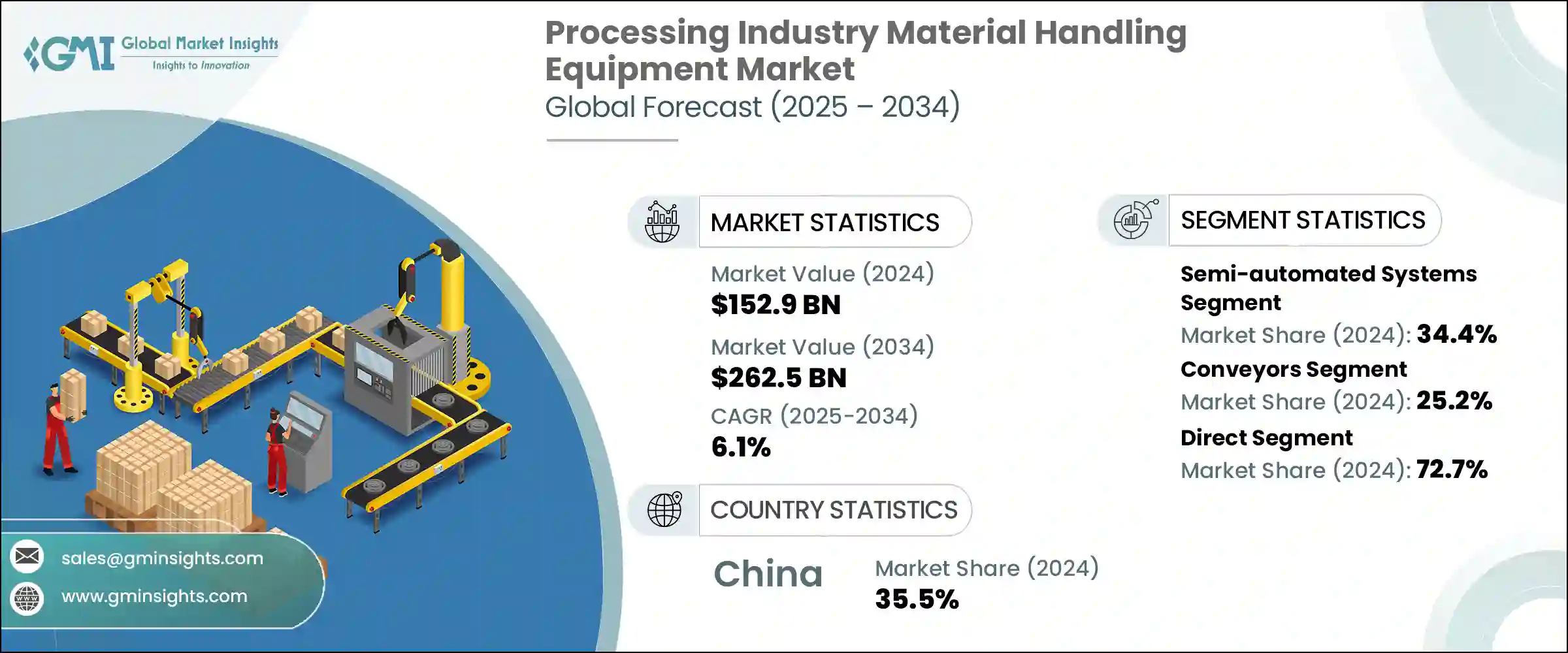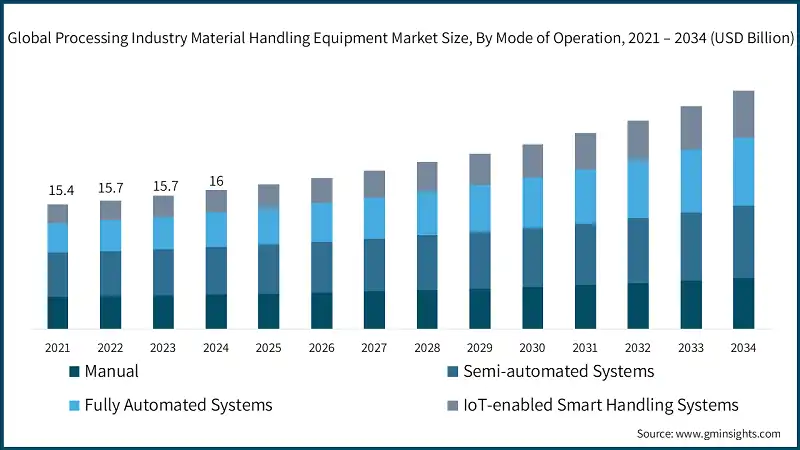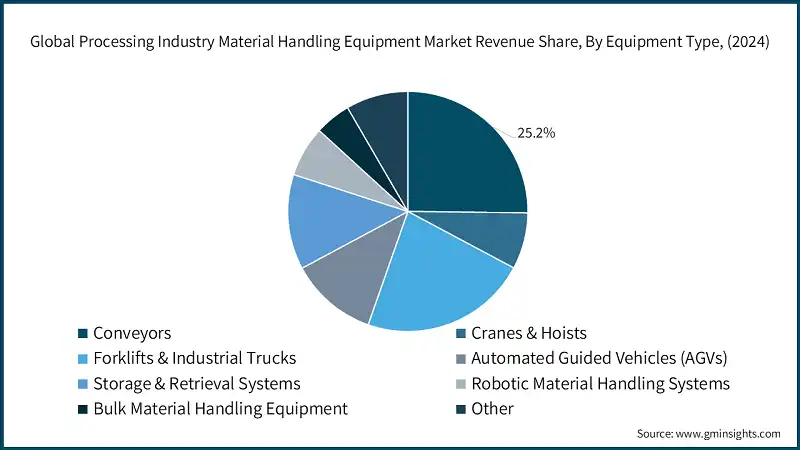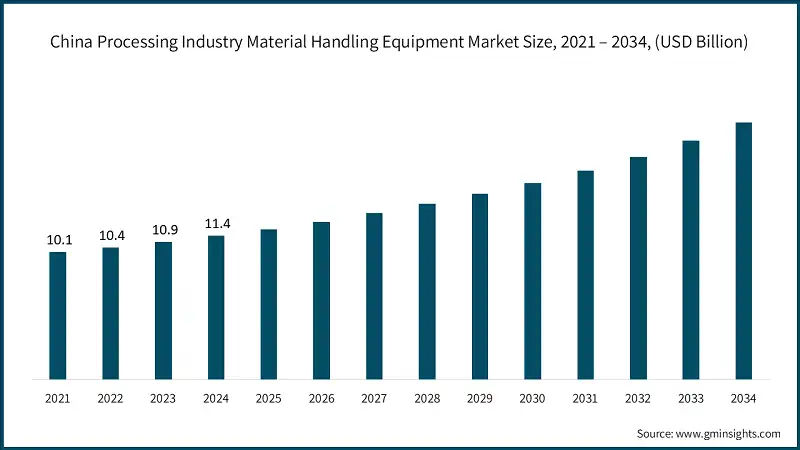Summary
Table of Content

Processing Industry Material Handling Equipment Market
Get a free sample of this report
Thank you!
Your inquiry has been received. Our team will reach out to you with the required details via email. To ensure that you don't miss their response, kindly remember to check your spam folder as well!
Form submitted successfully!
Error submitting form. Please try again.

Request Sectional Data
Thank you!
Your inquiry has been received. Our team will reach out to you with the required details via email. To ensure that you don't miss their response, kindly remember to check your spam folder as well!
Form submitted successfully!
Error submitting form. Please try again.
Processing Industry Material Handling Equipment Market Size
The global processing industry material handling equipment market size was estimated at USD 152.9 billion in 2024 and is expected to reach USD 262.5 billion by 2034, growing at a CAGR of 6.1% from 2025 to 2034. The market is on an upward trajectory to growth due to technological advancements and automation.

To get key market trends
Advances in robotics, artificial intelligence, and the integration of the internet of things (IoT), has restructured and automated the material handling process, allowing for real-time monitoring, precision control, and efficient management. Automation minimizes human error, decreases labor costs and improves safety, thereby making equipment more dependable and desirable for processing industries. These advancements help businesses take advantage of increased production and improve their workflow that leads to great increases in the use of modern material handling solutions.
Processing Industry Material Handling Equipment Market Report Attributes
| Key Takeaway | Details |
|---|---|
| Market Size & Growth | |
| Base Year | 2024 |
| Market Size in 2024 | USD 152.9 Billion |
| Forecast Period 2025 - 2034 CAGR | 6.1% |
| Market Size in 2034 | USD 262.5 Billion |
| Key Market Trends | |
| Drivers | Impact |
| Technological Advancements and Automation | Boost efficiency and reduce labor costs, driving higher demand for advanced material handling equipment. |
| Growth of E-commerce and Logistics | Increases the need for faster, more flexible handling solutions to manage growing shipment volumes. |
| Expansion of Industrial and Manufacturing Sectors | Fuels equipment demands as production and material movement requirements rise. |
| Pitfalls & Challenges | Impact |
| Maintenance Expenses and Complexity | Can limit adoption due to higher operational costs and downtime concerns. |
| Shortage of Skilled Workforce | This leads to operational delays and increased training costs, hindering efficient use and maintenance of material handling equipment. |
| High Initial Investment | Acts as a barrier to entry, slowing market growth, especially among small and medium enterprises. |
| Opportunities | Impact |
| Customizable and Modular Equipment Designs | Attracts diverse industries by offering scalable, flexible solutions suited to unique operational needs and space constraints. |
| Sustainability and Green Logistics Initiatives | Drives innovation in energy-efficient and eco-friendly equipment, aligning with environmental regulations and customer preferences. |
| Market Leaders (2024) | |
| Market Leader |
|
| Top Players |
Collective market share in 2024 is 16% |
| Competitive Edge |
|
| Regional Insights | |
| Largest Market | Asia Pacific |
| Fastest Growing Market | Asia Pacific |
| Emerging Countries | China and UK |
| Future outlook |
|
What are the growth opportunities in this market?
The continually rapid growth of both the e-commerce and logistics segments of the economy are a second major driver of market growth. The increase in online shopping has created demand that has driven up the size and variety of goods that must be efficiently processed, stored, and shipped. Material handling equipment like the conveyor, automated storage and retrieval systems (AS/RS), or sorting machines, are needed to respond to more demanding delivery times and accuracy. Growth in these sectors has made it necessary for businesses to invest in equipment that is flexible, develops scalability, and can handle varied products while also maximizing footprint utilization and minimizing costs.
Additionally, the increase of industrial and manufacturing markets around the globe is acting as a key driver for the need for material handling equipment. As business grows, also increases the need to transport raw, semi-finished and finished products inside a production facility. Emerging economies that are ramping up industrial efforts are heavily investing in modern infrastructure, too, which increases the demand for these modern material handling systems. These systems exist for a range of purposes, namely reducing the amount of manual, repetitive labor, safety increases, and improving productivity speeds.
According to Statista, it was estimated that material handling equipment will increase to 16.8 thousand units in 2030 with a compound annual growth rate of 9%.
Processing Industry Material Handling Equipment Market Trends
- The processing industry material handling equipment industry is evolving rapidly, driven by several key trends that are shaping the future of manufacturing and logistics operations. These trends include automation & robotics, IoT & real-time monitoring and sustainability approach.
- Automation and Robotics have the potential to revolutionize traditional material handling through improved speed, accuracy, and safety. Automated guided vehicles (AGVs), robotic arms, and conveyor systems eliminate human inaccuracy errors and labor costs by enhancing throughput times for product handling improvements. In this way, production times are shortened, while enhancing safety by having machines automate processes that are hazardous or repetitive in nature. The trajectory for adoption has already started, and in the next 10 years, many industries will realize classical robotics integration very quickly.
- The rise of IoT and real-time monitoring elevates material handling equipment by advancing the intellect of the device, or machines. For instance, the incorporation of sensors into machinery (like AGVs) means that data about the operation of the equipment can be collected continuously and monitored allowing companies to analyze the health of the machine, or the inventory coming off the machine, or project predictive maintenance of the equipment prior to an occurrence of a mechanical failure. This level of data availability can reduce downtime, reduce maintenance costs and planned use of resources.
- Sustainability and energy efficiency are emphasized areas now within the context of increased regulatory pressures and corporate responsibility initiatives. Energy-efficient motors, regenerative braking systems, and green materials can all decrease total net operating costs and improve negative environmental impacts. Companies manufacturing equipment with green technologies are likely to have a more favorable selection from those who wish to conduct sustainable practices. The adoption of sustainable equipment and use and sustainable practices will accelerate within 5-7 years driven both by legislation and consumer knowledge.
Processing Industry Material Handling Equipment Market Analysis

Learn more about the key segments shaping this market
Based on the mode of operation, the market is divided into manual, semi-automated systems, fully automated systems and IoT-enabled smart handling systems. In 2024, semi-automatic segment dominated the market accounting for around 34.4% share and is expected to grow at a CAGR of over 4.4% during 2025 to 2034.
- This dominance of semi-automatic segment is due to the balance which provides both flexibility and efficiency to companies. Semi-automated systems allow companies to increase productivity by automating or mechanizing repetitive tasks while still retaining human control. This is an important feature for processes that require some level of customization or variability. With semi-automated systems, companies can obtain automation advantages with minor investments, and the integration is typically simpler than using a fully automated system.
- Furthermore, semi-automated systems easily adapt into existing workflows and allow the business to lengthen the time to familiarize staff with more advanced automation that could be achieved over time. Semi-automated systems account for 34.4% of the market share where IoT-enabled smart handling systems account for 16% market share, but IoT-enabled smart handling systems grow faster at 7.9% CAGR compared to semi-automated systems’ 4.4%.

Learn more about the key segments shaping this market
Based on application, the processing industry material handling equipment market is segmented into conveyors, cranes & hoists, forklifts & industrial trucks, automated guided vehicles (AGVs), storage & retrieval systems, robotic material handling systems and bulk material handling equipment and other. In 2024, the conveyors segment dominates the with 25.2% of market share and is expected to grow at a CAGR of over 5.5% from 2025 to 2034.
- The conveyors segment is leading the processing industry material handling equipment market owing to its multitude of applications, flexibility, and productivity advantages in processing environments. Conveyors allow a continuous and automatic flow of conveying goods, raw material, and finished products throughout manufacturing plants, warehouses, and distribution centers and bolster productivity. Conveyors can be used to move a broad range of materials, from small components to heavy bulk items. They are commonly used in processing industries including food processing, pharmaceuticals, automotive, and logistics.
- In addition, conveyors facilitate decreased manual labor, faster operations, and can increase workplace safety by reducing the reliance on workers taking or moving heavier items. Given their cost, scalability, and compatibility with varying production requirements, conveyors continue to be a popular option for many processing industries. Conveyors account for 25.2% market share where robotic material handling systems account for 6.8% market share, but robotic material handling systems grow faster at 7.9% CAGR compared to conveyors’ 5.5%.
Based on the distribution channel, the processing industry material handling equipment market is segmented as direct and indirect. In 2024, the direct segment dominates the market with 72.7% revenue share and is expected to grow at a CAGR of over 4.7% from 2025 to 2034.
- The indirect segment is dominant in the processing industry material handling equipment sector primarily due to reach and the ability to support a wider range of customers using broader solutions. Indirect channels also provide the customer with additional value with services that can include product personalization, after-sales service, maintenance or even financing options which can help facilitate customer adoption of processing and material handling solutions in their operations.
- Additionally, indirect channels have established networks and regional footprints which allow them to service various geographic markets much more effectively. Being more visible helps manufacturers deepen their market penetration without needing a large direct sales force.

Looking for region specific data?
In 2024, China dominated with around 35.5% share in APAC the processing industry material handling equipment market and is set to cross USD 2 billion by 2034.
- China is leading the processing industry material handling equipment industry in the Asia-Pacific region for several important reasons. Economically, China’s industrial growth and large manufacturing base create a strong demand for effective material handling solutions. The Chinese government’s position encourages such a transition with programs such as “Made in China 2025,” which promotes automation and smart factories.
- Demographically, with many Chinese workers and an increasing urban population, there is a growing demand for modern logistics and warehousing equipment. In addition, attempts by the local government to industrialize central and western China is presenting a developing area for growth that will require equipment.
In North America, the processing industry material handling equipment market in the U.S. is expected to experience significant and promising growth from 2025 to 2034.
- The United States holds the largest market share of all the North American markets for processing industry material handling equipment due to several reasons. Firstly, in terms of GDP, the US Bureau of Economic Analysis shows that the United States has one of the largest, diverse manufacturing sectors in the world that drives demand for advanced material handling solutions to improve the efficiency of processes and reduce the potential for waste.
- Secondly, there is substantial regulatory support for workplace safety and environmental regulations that require companies to upgrade to more modernized automated equipment. Lastly, there is a large skilled workforce in the US that is paired with increasing investments in smart warehouses and e-commerce fulfillment centers that contribute to market expansion. The processing industry material handling equipment market has also expanded to include Emerging sectors such as Renewable energy and Pharmaceuticals, which also provides opportunities for providers.
In Europe, the UK processing industry material handling equipment market is expected to experience significant and promising growth from 2025 to 2034.
- The United Kingdom utilizes a robust manufacturing and logistics sector. The manufacturing and logistics sector depends on efficient material handling solutions that increase their competitiveness. Regulatory support for sustainability and safety is encouraging the uptake of energy efficient and automated equipment. Demographics such as a skilled workforce and growing urbanization are increasing the demand for an increased warehouse and processing capacity.
- Emerging markets such as pharmaceuticals, food processing, and e-commerce are providing new possibilities for growth. The United Kingdom is a leader in the material handling equipment market in the region because of its commitment to innovation, regulatory and policy frameworks, and new industrial activities.
In MEA, the processing industry material handling equipment market in UAE is expected to experience significant and promising growth from 2025 to 2034.
- The UAE's prime position as a global trade and logistics center stimulates demand for innovative material handling technology to complement its congested ports, warehouse sites, and make valuable contributions to the manufacturing industry. Regulatory approaches call for a 'smart' city with developments built for the cities of the future, consequently the UAE is promoting investment in automation and energy-efficient technology. Additionally, with one of the youngest and most skilled workforces in MEA, the net number of automated solutions is becoming more plentiful. Automated warehouses are sprouting up rapidly in the UAE.
- Turnover per employee is also multiplied when utilizing a workstation or a forklift. In addition, there are new sectors that are bolstering the overall trend, for example, e-commerce, food processing, pharmaceuticals. The combination of innovative applications to smart cities, development and infrastructure, makes the UAE market leader in MEA's market.
Processing Industry Material Handling Equipment Market Share
- Toyota Industries Corporation leads with 7.9% market share due to strong focus on technological innovation and integrated automation solutions. The top 5 companies are GEA, KION Group, Fives Group, Toyota Industries Corporation and Tetra Pak which collectively hold 20-25% of the market, indicating moderate market concentration.
- KION Group is the global leader in industrial trucks and warehouse automation, using automation, robotics and IoT technologies to connect to its products. KION also aims to support supply chain efficiency by providing innovative material handling solutions using Industry 4.0. Its strong emphasis on research and development and a wide product portfolio enable it to cater to diverse industries worldwide, driving growth through technological advancement and customer-centric services.
- Fives Group provides engineering and manufacturing of customized material handling systems for heavy industry. Fives Group develops, incorporates and delivers a wide variety of automation. Through automation and digitalization, Fives Group works to improve the overall manufacturing processes and will work with the customers to provide customized solutions that create efficiencies and reduce operational costs. Fives Group focuses on precision engineering and advanced software enabling the leadership in complex industrial environments with their equipment management services needing high-performance equipment.
- Continuing to deliver safety, energy-efficient solutions, and innovation globally, Toyota Industries Corporation is the market leader that mint function provides a range of different material handling equipment such as out of even the one forklifts and automated guided vehicles (AGVs). Toyota’s patent safety technologies, eco-friendliness and/or service globally and reliable and sustainable operations, keep them ahead of the competition.
- Tetra Pak is known for their focused-on food safety, operational performance, and sustainability with low energy processing lines, aseptic systems, and Clean-in-Place (CIP) equipment to minimize energy use and waste. The company provides digital solutions for traceability, plant optimization, lifecycle support and automation to ink quality and efficient production which makes them lead in automation and digitization.
Processing Industry Material Handling Equipment Market Companies
Major players operating in the processing industry material handling equipment industry are:
- Crown Equipment Corporation
- Daifuku
- Dematic Group
- Fives Group
- GEA
- Hyster-Yale Materials Handling
- Intelligrated (a Honeywell company)
- JBT Corporation
- Jungheinrich
- KION Group
- Linde Material Handling
- Mitsubishi Logisnext
- SSI Schaefer Group
- Tetra Pak
- Toyota Industries Corporation
Toyota Industries Corporation is a large manufacturer and global leader in material handling equipment with revenues greater than USD 17 billion in 2024. In 2024, Toyota launched a new generation of electric forklifts that feature advanced battery technologies. This product vertical in material handling equipment provides insight into the company as an innovative and environmentally responsible operator. Fives provides customized conveying and sorting solutions that are high efficiency and deliver reduced downtime in complex industrial settings. A recent project success for Fives includes winning a contract to install a fully automated handling system at a large steel plant in Europe. The project highlights Fives capabilities for large-scale applications in heavy duty industries. KION Group is a worldwide leader within material handling and logistics solutions with about USD 12.4 billion in revenue in 2024. KION is a global leader in material handling and logistics solutions with revenue of approximately USD 12 billion in 2024. The company has an extensive product catalog of logistics solutions like Forklifts, Automated Guided Vehicles, warehouse management software, etc. KION owns brands like Linde and STILL, which adds to the company's brand power and its strategic positioning. KION Company is making meaningful investments in robotics and artificial intelligence and how to automate more functions with these applications to meet the increased demand for smart warehouses. GEA Group is a global leader in process engineering solutions and related material handling solutions for food, beverage, and pharmaceutical industries. The GEA group reported steady growth of approximately USD 5.8 billion in revenue in 2024. With GEA’s leading rate of growth, the company's focus is on energy-efficient and sustainable technology. The company offers a wide range of equipment, including pneumatic conveyors and automated processing systems, designed to optimize bulk material handling while maintaining high hygiene standards.
Processing Industry Material Handling Equipment Industry News
- In 2025, Jungheinrich revealed its expansive Strategy 2030+, for US$ 11 billion in revenues and 10% EBIT ROS by 2030 through organic growth and M&A. The strategy is for global presence expansion in North America and Asia-Pacific, accelerated innovation in warehouse automation, and expanding its product portfolio as well as mid-tech industrial trucks with the use of its new branding "AntOn". Jungheinrich is looking to improve productivity and sustainability by pursuing net-zero emissions by 2030 whilst also bolstering its market-leading position in material handling solutions using AI and digital transformation.
- Dematic presented new automation technologies at ProMat 2025, including AutoStore™, AMRs, the Multishuttle, and the Eurofork 4es, which further advanced its existing solutions to improve efficiency and scale in material handling. Dematic placed high value on integrating AI, developing energy-efficient systems, and building partnerships with AutoStore, Eurofork, and Linde to address a continuing shortage of labor, particularly during supply chain interruptions. In addition to expert sessions and live demonstrations, Dematic reiterated its commitment to be thought leaders in smart, adaptable, and sustainable solutions to material handling in the processing industry.
- In 2025, Crown Equipment Corporation displayed its latest innovations in material handling at INTRALOGISTICA ITALIA 2025, including the ESR 1200 reach truck featuring a unique Xpress Lower technology, which raises productivity by 21% and reduces overall energy consumption by 11%. They also showcased the WP 3210 electric pallet truck and WAV 60 Work Assist Vehicle. Eddie Zwigk, who is a Managing Director, said that Crown Equipment is prioritizing ergonomics, efficiency and added automation in all aspects of industrial operations.
The processing industry material handling equipment market research report includes in-depth coverage of the industry with estimates & forecasts in terms of revenue ($ Bn) and volume (Thousand Units) from 2021 to 2034, for the following segments:
Market, By Mode of Operation
- Manual handling equipment
- Semi-automated systems
- Fully automated systems
- IoT-enabled smart handling systems
Market, By Equipment Type
- Conveyors
- Cranes & hoists
- Forklifts & industrial trucks
- Automated guided vehicles (AGVs)
- Storage & retrieval systems
- Robotic material handling systems
- Bulk material handling equipment
- Other
Market, By Application
- Efficient movement of materials
- Storage and organization
- Improving safety
- Increasing productivity
- Other
Market, By End Use Industry
- Food & beverage processing
- Chemical and pharmaceutical processing
- Mining & metals processing
- Pharmaceutical manufacturing
- Oil & gas
- Logistics
- Automotive and electronics manufacturing
- Other
Market, By Distribution Channel
- Direct
- Indirect
The above information is provided for the following regions and countries:
- North America
- U.S.
- Canada
- Europe
- Germany
- UK
- France
- Italy
- Spain
- Asia Pacific
- China
- India
- Japan
- South Korea
- Australia
- Latin America
- Brazil
- Mexico
- MEA
- South Africa
- Saudi Arabia
- UAE
Frequently Asked Question(FAQ) :
What is the market trend by distribution channel in the processing industry material handling equipment market?
Direct distribution channels dominate with a 72.7% share, but indirect channels offer growth potential due to after-sales service, financing, and market reach across regions.
Which companies are leading the processing industry material handling equipment market?
Key players in the processing industry material handling equipment market include Toyota Industries Corporation, GEA Group, KION Group, Fives Group, Tetra Pak, and Dematic Group. These companies stand out due to innovation in automation, robotics, sustainability, and digital solutions.
How are IoT-enabled smart handling systems performing in the processing industry material handling equipment industry?
IoT-enabled smart handling systems are rapidly gaining traction, with a growth rate of 7.9%, outpacing other segments due to real-time monitoring, predictive maintenance, and data-driven operations.
Which mode of operation is most adopted in the processing industry material handling equipment market?
Semi-automated systems lead the market with a 34.4% revenue share, offering a balance between manual control and automation, especially in industries requiring process flexibility.
What are the key drivers behind the processing industry material handling equipment market growth?
The adoption of automation, IoT integration, manufacturing expansion, along with e-commerce demand will drive the demand for processing industry material handling equipment.
Which region leads the processing industry material handling equipment market?
Asia Pacific holds the largest and fastest-growing share in the processing industry material handling equipment market, with China being a major contributor due to industrialization and smart factory initiatives.
Which countries are emerging as high-growth markets for material handling equipment?
China and the UK are emerging as key growth markets in the processing industry material handling equipment sector, driven by automation, infrastructure development, and logistics expansion.
What equipment type holds the largest share in the processing industry material handling equipment market?
Conveyors dominated the processing industry material handling equipment industry with a 25.2% revenue share in 2024 due to their widespread usage in food processing, logistics, and pharmaceuticals.
What was the size of the processing industry material handling equipment market in 2024?
The processing industry material handling equipment market was valued at USD 152.9 billion in 2024.
What is the forecast market size of the processing industry material handling equipment market?
The processing industry material handling equipment market is projected to reach USD 262.5 billion by 2034, growing at a 6.1% CAGR.


